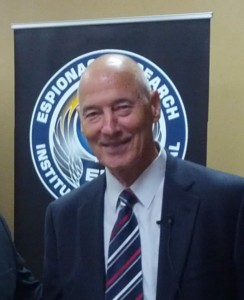Jack Platt (John C. Platt) passed away on Jan 4, 2017 at the age of 80.
Jack had forged a lasting friendship with KGB officer Gennadiy Vasilenko, beginning in the 1970’s. Vasilenko suffered at the hands of of the KGB partly due to his relationship with Platt and was put in prison twice. After his second imprisonment of five years, from 2005 to 2010, he was able to be released as part of a spy trade with the US.
Gennadiy Vasilenko and Mr. Platt were keynote speakers at the 2013 conference of ERII (Espionage Research Institute International). Jack introduced Mr. Vasilenko who proceeded to tell their story, while Jack quietly took a seat in the back of the room. Some of their complicated relationship was explained in a recent NY Times article.


Jack Platt and Gennadiy Vasilenko; Vasilenko at the ERII conference in 2013
Mr. Platt, who had joined the C.I.A. in 1963, met Mr. Vasilenko in the late 1970s while he was based in Washington, where he was trying to identify and meet K.G.B. officers posted there with the aim of recruiting them to spy for the United States.
In 1977, a Soviet defector told Mr. Platt that one of his classmates from the K.G.B.’s training institute was working under diplomatic cover at the Soviet Embassy in Washington. The classmate he identified was Mr. Vasilenko.
“Halfway through the game I realized, I really like this guy,” he recalled in an interview in 1997.
Mr. Vasilenko, a tall, gregarious Russian, had been a highly skilled volleyball player whose dream of making the Soviet national team in time for the 1964 Olympics had been dashed by injuries. Instead, he joined the K.G.B., and in 1976 he had been assigned to the K.G.B. station in Washington.
When they first met, Jack was trying to recruit Vasilenko to become a spy for the US, but Mr. Vasilenko always rebuffed him.
“I never stopped trying to recruit him,” Mr. Platt said in 1997. “But he never crossed the line.”
In fact, even as Mr. Platt and Mr. Vasilenko struck up their friendship, Mr. Vasilenko was secretly handling an important American spy without revealing the spy’s existence to Mr. Platt. The American was Ronald Pelton, a former National Security Agency staff member who had walked into the Soviet Embassy in Washington in 1980 and told the Soviets about a secret American operation to eavesdrop on Soviet communications by tapping into an underwater cable off the coast of the Soviet Union.
Mr. Pelton was not unmasked until he was compromised by Vitaly Yurchenko, a K.G.B. officer who defected in 1985.
Meanwhile, Mr. Platt and Mr. Vasilenko continued to meet, and Mr. Platt continued to try to recruit him as they drank together, went hunting and shooting together, and had dinner together at the Vasilenko home with Mr. Vasilenko’s wife and children.
Mr. Vasilenko eventually stopped reporting his contacts with Mr. Platt to his K.G.B. bosses. He even kept up the relationship after his supervisors, who were growing suspicious, told him to break it off.
In 1981, Mr. Vasilenko was transferred back to Moscow, and the two men lost contact with each other.
Mr. Vasilenko eventually stopped reporting his contacts with Mr. Platt to his K.G.B. bosses. He even kept up the relationship after his supervisors, who were growing suspicious, told him to break it off.
In 1981, Mr. Vasilenko was transferred back to Moscow, and the two men lost contact with each other.
But Mr. Vasilenko resurfaced when he was assigned to Guyana, and Mr. Platt visited him there in the fall of 1987. Mr. Platt retired from the C.I.A. that year but stayed on as a contractor into 1988, specifically to keep trying to lure Mr. Vasilenko into espionage.
But then Mr. Vasilenko vanished after flying to Cuba from Guyana in January 1988. On his arrival he was arrested by K.G.B. operatives and interrogated about his relationship with Mr. Platt.
Mr. Ames, who had begun spying for the Soviets in 1985, almost certainly gave Moscow C.I.A. files that contained Mr. Platt’s reports on his contacts with Mr. Vasilenko.
Fortunately for Mr. Vasilenko, Mr. Platt, in his reports to his superiors, had never exaggerated their relationship by claiming to have recruited Mr. Vasilenko to spy for the United States. The reports showed only that Mr. Vasilenko had held unauthorized meetings with Mr. Platt.
The K.G.B. held Mr. Vasilenko for six months. Without evidence that he had spied for the Americans, the Russians released him and forced him out of the K.G.B.
Mr. Platt did not find out that Mr. Vasilenko was still alive until August 1991. They reconnected and eventually went into international business together.
In 2005, however, Mr. Vasilenko was once again arrested by the Russian authorities, this time on weapons charges. In an interview on Monday, Mr. Vasilenko said he believed the real reason for that arrest was that he had helped a former K.G.B. colleague get a visa to the United States, without realizing that the former colleague had provided information to the United States that helped unmask the former F.B.I. agent Robert Hanssen as a spy for Moscow.
In 2010, Mr. Vasilenko was released to the United States as part of a spy trade in which four Russians who had been seized by the Soviet authorities were exchanged for 10 Russian sleeper agents who had been arrested by the United States.
